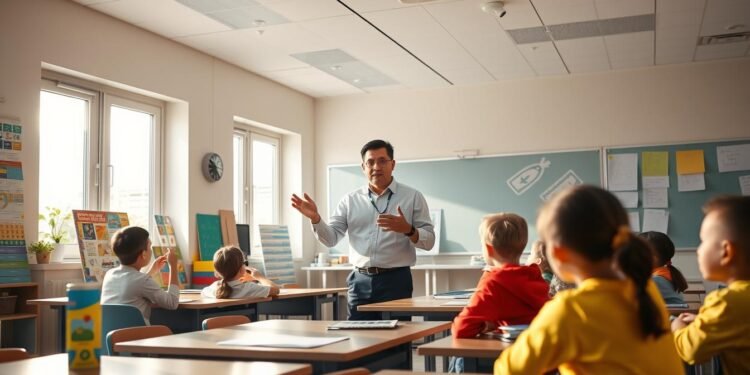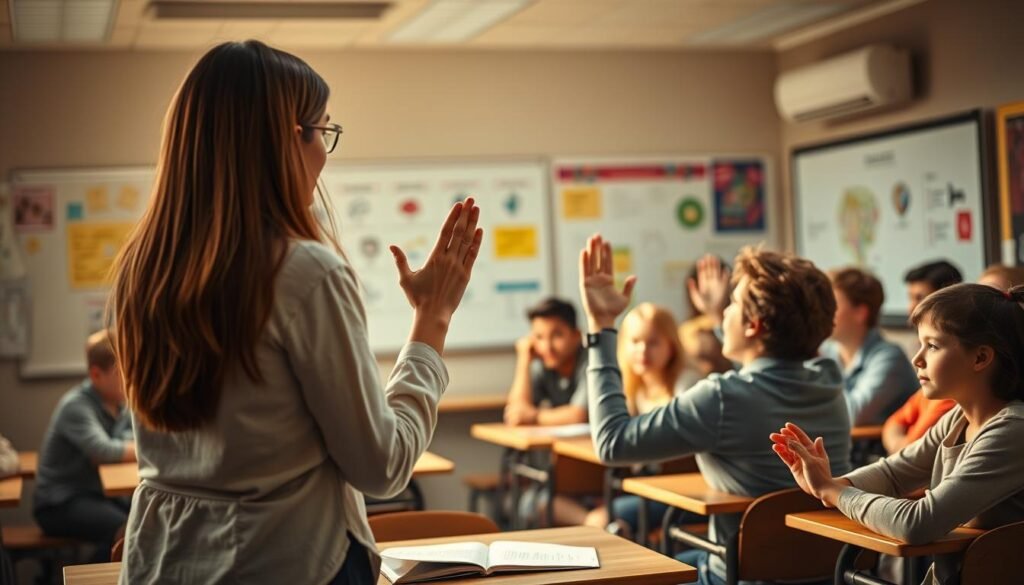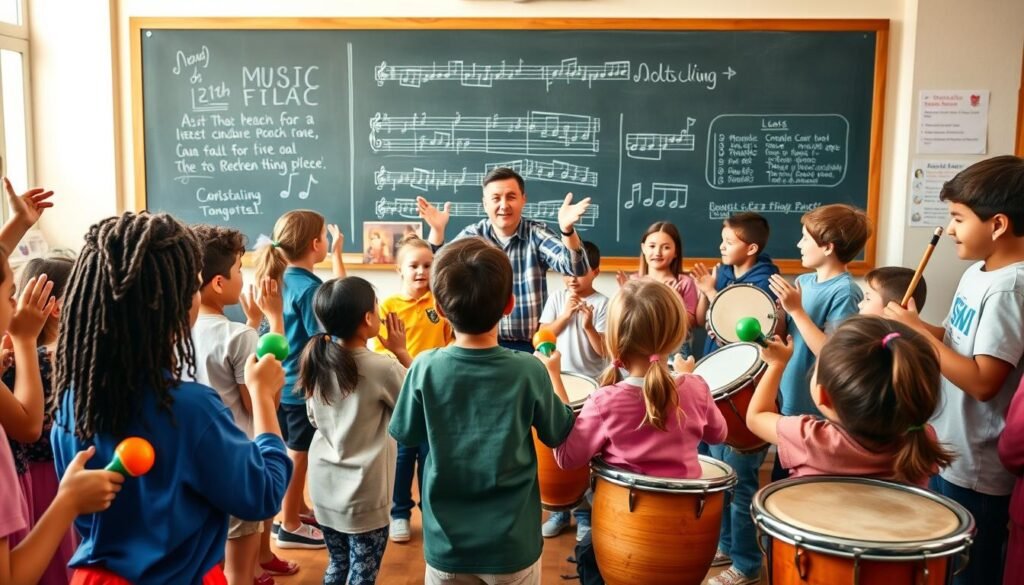Have you ever wondered how some educators seamlessly transition their class from one activity to the next? The secret lies in effective strategies that keep students engaged and focused. Whether it’s a rhythmic cue or a silent signal, these methods are game-changers for maintaining smooth class management.
Interactive call-and-response phrases are a popular choice. These two-part cues require participation, making them ideal for keeping students attentive. For example, a teacher might say, “Hands on top,” and the class responds, “Everybody stop!” This simple yet effective technique works across grade levels, from elementary to middle school.
Modern solutions like wireless doorbells with 52 chime options or light flicking are also gaining traction. These tools help reduce repetition of instructions, saving valuable lesson time. With 85% of teachers reporting faster transitions, it’s clear that these strategies are worth exploring.
Key Takeaways
- Interactive call-and-response phrases boost student participation.
- Silent signals and rhythmic cues are effective for smooth transitions.
- Modern tools like wireless doorbells enhance class management.
- Adapting strategies for different grade levels ensures success.
- Effective cues reduce the need for repeated instructions.
Why Attention Getters Are Essential for Classroom Management
What makes a classroom run efficiently? The answer lies in smart strategies. Attention-getters are more than just tools; they are the backbone of effective classroom management. These techniques help teachers maintain focus, save time, and create a positive learning environment.
Studies show that musical cues can speed up transitions by 73%. Middle school teachers report a 40% reduction in repeated instructions when using these methods. This not only saves valuable time but also keeps students engaged and on track.
Predictable routines reduce cognitive load for students. They know what to expect, which helps them focus better. For instance, daily call-and-response traditions build a sense of community. These shared practices make transitions smoother and more enjoyable.
Non-verbal alternatives, like hand signals or visual cues, reduce strain on a teacher’s voice. They also allow quick redirection during high-energy activities or technology-based lessons. This approach supports differentiated needs, catering to kinesthetic, auditory, and visual learners.
By establishing authority without confrontation, teachers can manage their classrooms more effectively. These strategies ensure that instructional time is used wisely, saving up to 15 minutes daily. Over the course of a year, these small changes add up to significant improvements in productivity and engagement.
Call-and-Response Attention Getters
Ever thought about how simple phrases can transform a noisy room into a focused space? Call-and-response techniques are a proven way to engage students and maintain order. These interactive cues encourage participation and create a sense of unity.
Interactive Phrases That Work
Popular phrases like “If you can hear me, clap once” or “Eyes on me, hands on your head” are effective across all ages. These cues are simple yet powerful. They set clear expectations and help students transition smoothly between activities.
Middle school sources suggest using proximity strategies. Standing close to distracted learners while giving cues can reinforce focus. This small bit of effort makes a big difference.
Tips for Effective Use
Here are some practical tips to maximize the impact of call-and-response techniques:
- Start with a 3-step training process: Explain, Model, and Practice. A music teacher recommends a 2-week practice period for mastery.
- Use hand signals or ASL signs alongside verbal cues to support visual learners.
- Gradually lower your voice to a whisper to train students to focus on quieter prompts.
- Rotate five core phrases monthly to keep the approach fresh and engaging.
- Pair cues with a reward system, like “Beat the clock” challenges, to motivate participation.
- Coordinate with specials teachers to ensure consistency across different settings.
- Document student-created variations in a “Cue Catalog” to foster ownership and creativity.
By following these tips, you can create a more dynamic and responsive learning environment. These strategies not only save time but also empower students to take charge of their focus.
Fun and Creative Attention Getters
Looking for ways to make learning more engaging and fun? Incorporating humor, pop culture, and movement can transform your room into a lively space. These strategies not only capture students’ focus but also make transitions enjoyable.
Using Humor and Pop Culture
Humor is a powerful tool to lighten the mood. Try phrases like “If you can hear me, put your hands on your head.” Pop culture references, such as quoting popular movies or songs, can also grab students’ eyes and ears. These things make learning relatable and fun.
Adding Movement
Movement-based cues are great for kinesthetic learners. Use a simple clap pattern or desk percussion sequences like knock-knock-clap. Yoga poses, such as holding the tree pose during transitions, add a calming element. Mirror exercises, where students copy your slow motions, can also be effective.
Balance challenges, like a “statue contest” during cleanup, encourage focus. Designated wall touches for line formation add structure. These creative strategies keep everyone involved and make transitions seamless.
Rhythmic and Musical Attention Getters
Have you considered how rhythm and music can transform your teaching approach? These tools are a way to engage students and make transitions smoother. By incorporating sound, you can create a dynamic and focused learning environment.
Clapping and Echoing Rhythms
Clapping patterns are simple yet effective. Start with a basic rhythm and have students echo it back. This method works well for all ages and keeps everyone engaged. It’s also a great way to signal transitions without using words.
Integrating Instruments
Adding instruments like chimes, hand drums, or kazoos can make transitions fun. For example, a xylophone can play a familiar tune to signal cleanup time. DIY options like rice shakers or bucket drums are also popular.
Try assigning a weekly rhythm leader to conduct the class. This gives students ownership and keeps the approach fresh. Digital tools like GarageBand can also be used for soundboard cues, adding a modern twist.
For mindfulness transitions, harmonic chime baths are calming. Pitch matching, where the teacher plays a note and students hum back, is another creative idea. These techniques make learning interactive and enjoyable.
Silent Cues and Visual Signals
Silent cues and visual signals can transform how students respond in a classroom. These non-verbal strategies are effective for maintaining focus and ensuring smooth transitions. They reduce the need for repeated instructions and create a calm learning environment.
Raising Hands and Using Posters
Simple gestures like raising a hand can signal students to pause and listen. Posters with clear instructions or visual reminders are also helpful. For example, a poster with a “Quiet Zone” sign can remind students to lower their voices during independent work.
Wireless Doorbells and Light Flicking
Modern tools like wireless doorbells with 52 chime options are gaining popularity. These devices allow teachers to signal transitions without raising their voices. Light flicking is another effective method. Smart bulbs can change colors to indicate different activities, such as blue for transitions and red for emergencies.
Other innovative ideas include themed sound kits, like jungle noises or space sounds, to make transitions fun. Vibration floor pads can assist hearing-impaired students, while motion-activated projectors display instructions clearly. Decibel meter displays show noise levels, and haptic feedback watches provide individual alerts.
These silent and visual cues save time and keep the room organized. They cater to diverse learning needs and make classroom management more efficient.
Conclusion
Effective strategies for maintaining focus can significantly improve learning outcomes. Consistency is key when implementing these methods. A gradual 6-month plan allows both students and teachers to adapt smoothly. Gathering feedback from students helps refine cue selection, ensuring relevance and engagement.
Cross-grade consistency in school-wide systems fosters a unified approach. Tracking time saved per subject area provides measurable results. Professional development workshops equip teachers with innovative tools and techniques. Involving parents through home signal kits extends these practices beyond the classroom.
By prioritizing consistency and engagement, educators can create a more focused and productive learning environment. These strategies not only save time but also empower students to take ownership of their learning journey.
FAQ
Why are attention getters important in a classroom setting?
They help teachers quickly refocus students, maintain order, and ensure smooth transitions between activities. Effective cues save time and keep lessons on track.
What are some examples of call-and-response techniques?
Phrases like “Red Robin” with students responding “Yum!” or “Class, class” with “Yes, yes!” are popular. These interactive methods engage kids and encourage participation.
How can humor and pop culture be used to grab focus?
Incorporating familiar tunes, memes, or funny phrases can make cues more relatable and fun. For example, using a trending catchphrase as a signal can instantly capture interest.
What role does movement play in attention strategies?
Adding actions, like clapping or hand gestures, helps students stay engaged. Physical responses also reinforce the cue, making it easier to remember.
How do rhythmic and musical cues work?
Clapping a specific rhythm or using instruments like tambourines creates an auditory signal. Students echo the sound, which quickly draws their focus.
What are silent cues, and why are they effective?
Raising a hand, flicking lights, or using a wireless doorbell provides a non-verbal way to signal students. These methods are especially useful in noisy environments.
How can teachers ensure these strategies work consistently?
Practice and repetition are key. Set clear expectations, model the desired response, and reinforce the cues regularly to make them a natural part of the routine.









